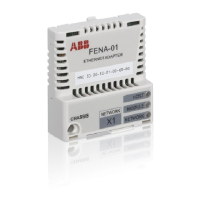324 PROFINET IO – Communication protocol
PROFINET IO uses three different communication channels to
exchange data:
• The standard UDP/IP and TCP/IP channel is used for
parameterization and configuration of devices and for acyclic
operations.
• The real time (RT) channel is used for cyclic data transfer and
alarms.
• The isochronous real time (IRT) channel is used, for example,
in motion control applications (not implemented in FENA).
PROFINET IO devices are structured in slots and sub-slots, which
can contain modules and sub-modules correspondingly. A device
can have almost any number of slots and sub-slots, and they can
be virtual or real. Device-specific data is represented in slot 0;
module-specific and sub-module-specific data in subsequent slots
and sub-slots.
One of the benefits of PROFINET IO is the diagnostics and alarm
mechanism. Every module and sub-module provide alarm data to
the I/O controller using the cyclic channel. Diagnostic data can be
read non-cyclically from the device by using record data.
The properties and services of a PROFINET IO device are
described in a GSD file written in GSDML (General Station
Description Markup Language). The GSD file describes the
device-specific modules and the method of assigning modules and
sub-modules to predefined slots and sub-slots. For more
information, see section Downloading the GSD file on page 289.

